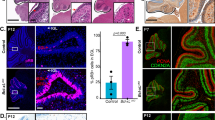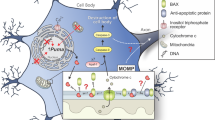Abstract
Short-term proteasome inhibition has been shown to prevent neuronal apoptosis. However, the key pro-survival proteins that must be degraded for triggering neuronal death are mostly unknown. Here, we show that Mcl-1, an anti-apoptotic Bcl-2 family member, is degraded by the proteasome during neuronal apoptosis. Using primary cultures of cerebellar granule neurons deprived of serum and KCl, we found that ubiquitination and proteasomal degradation of Mcl-1 depended on its prior phosphorylation by GSK3, providing the first insight into post-translational regulation of Mcl-1 in neurons. In a previous study, we have reported that the E3 ubiquitin-ligase Trim17 is both necessary and sufficient for neuronal apoptosis. Here, we identified Trim17 as a novel E3 ubiquitin-ligase for Mcl-1. Indeed, Trim17 co-immunoprecipitated with Mcl-1. Trim17 ubiquitinated Mcl-1 in vitro. Overexpression of Trim17 decreased the protein level of Mcl-1 in a phosphorylation- and proteasome-dependent manner. Finally, knock down of Trim17 expression reduced both ubiquitination and degradation of Mcl-1 in neurons. Moreover, impairment of Mcl-1 phosphorylation, by kinase inhibition or point mutations, not only decreased ubiquitination and degradation of Mcl-1, but also blocked the physical interaction between Trim17 and Mcl-1. As this stabilization of Mcl-1 increased its neuroprotective effect, our data strongly suggest that Trim17-mediated ubiquitination and degradation of Mcl-1 is necessary for initiating neuronal death.
Similar content being viewed by others
Log in or create a free account to read this content
Gain free access to this article, as well as selected content from this journal and more on nature.com
or
Abbreviations
- CGN:
-
cerebellar granule neurons
- GSK3:
-
Glycogen Synthase Kinase 3
- [KCl]o:
-
extracellular concentration of KCl
- K25:
-
serum-free medium containing 25 mM KCl
- K5:
-
serum-free medium containing 5 mM KCl
- JNK:
-
c-Jun N-terminal protein kinase
- WT:
-
wild type
- GFP:
-
green-fluorescent protein
- shRNA:
-
short hairpin RNA
- DIV:
-
days in vitro
References
Yuan J, Yankner BA . Apoptosis in the nervous system. Nature 2000; 407: 802–809.
Chipuk JE, Moldoveanu T, Llambi F, Parsons MJ, Green DR . The BCL-2 family reunion. Mol Cell 2010; 37: 299–310.
Warr MR, Shore GC . Unique biology of Mcl-1: therapeutic opportunities in cancer. Curr Mol Med 2008; 8: 138–147.
Nijhawan D, Fang M, Traer E, Zhong Q, Gao W, Du F et al. Elimination of Mcl-1 is required for the initiation of apoptosis following ultraviolet irradiation. Genes Dev 2003; 17: 1475–1486.
Ding Q, He X, Hsu JM, Xia W, Chen CT, Li LY et al. Degradation of Mcl-1 by beta-TrCP mediates glycogen synthase kinase 3-induced tumor suppression and chemosensitization. Mol Cell Biol 2007; 27: 4006–4017.
Maurer U, Charvet C, Wagman AS, Dejardin E, Green DR . Glycogen synthase kinase-3 regulates mitochondrial outer membrane permeabilization and apoptosis by destabilization of MCL-1. Mol Cell 2006; 21: 749–760.
Sitailo LA, Tibudan SS, Denning MF . The protein kinase C delta catalytic fragment targets Mcl-1 for degradation to trigger apoptosis. J Biol Chem 2006; 281: 29703–29710.
Zhang J, D’Ercole AJ . Expression of Mcl-1 in cerebellar granule neurons is regulated by IGF-I in a developmentally specific fashion. Brain Res Dev Brain Res 2004; 152: 255–263.
Mori M, Burgess DL, Gefrides LA, Foreman PJ, Opferman JT, Korsmeyer SJ et al. Expression of apoptosis inhibitor protein Mcl1 linked to neuroprotection in CNS neurons. Cell Death Differ 2004; 11: 1223–1233.
Arbour N, Vanderluit JL, Le Grand JN, Jahani-Asl A, Ruzhynsky VA, Cheung EC et al. Mcl-1 is a key regulator of apoptosis during CNS development and after DNA damage. J Neurosci 2008; 28: 6068–6078.
Germain M, Nguyen AP, Le Grand JN, Arbour N, Vanderluit JL, Park DS et al. MCL-1 is a stress sensor that regulates autophagy in a developmentally regulated manner. EMBO J 2011; 30: 395–407.
D'Mello SR, Galli C, Ciotti T, Calissano P . Induction of apoptosis in cerebellar granule neurons by low potassium: inhibition of death by insulin-like growth factor I and cAMP. Proc Natl Acad Sci USA 1993; 90: 10989–10993.
Wood KA, Dipasquale B, Youle RJ . In situ labelling of granule cells for apoptosis-associated DNA fragmentation reveals different mechanisms of cell loss in developing cerebellum. Neuron 1993; 11: 621–632.
Desagher S, Severac D, Lipkin A, Bernis C, Ritchie W, Le Digarcher A et al. Genes regulated in neurons undergoing transcription-dependent apoptosis belong to signaling pathways rather than the apoptotic machinery. J Biol Chem 2005; 280: 5693–5702.
Bobba A, Canu N, Atlante A, Petragallo V, Calissano P, Marra E . Proteasome inhibitors prevent cytochrome c release during apoptosis but not in excitotoxic death of cerebellar granule neurons. FEBS Lett 2002; 515: 8–12.
Butts BD, Hudson HR, Linseman DA, Le SS, Ryan KR, Bouchard RJ et al. Proteasome inhibition elicits a biphasic effect on neuronal apoptosis via differential regulation of pro-survival and pro-apoptotic transcription factors. Mol Cell Neurosci 2005; 30: 279–289.
Canu N, Barbato C, Ciotti MT, Serafino A, Dus L, Calissano P . Proteasome involvement and accumulation of ubiquitinated proteins in cerebellar granule neurons undergoing apoptosis. J Neurosci 2000; 20: 589–599.
D’Mello SR, Kuan CY, Flavell RA, Rakic P . Caspase-3 is required for apoptosis-associated DNA fragmentation but not for cell death in neurons deprived of potassium. J Neurosci Res 2000; 59: 24–31.
Porcile C, Piccioli P, Stanzione S, Bajetto A, Bonavia R, Barbero S et al. Proteasome inhibitors induce cerebellar granule cell death: inhibition of nuclear factor-kB activation. Ann NY Acad Sci 2002; 973: 402–413.
Inuzuka H, Shaik S, Onoyama I, Gao D, Tseng A, Maser RS et al. SCFFBW7 regulates cellular apoptosis by targeting MCL1 for ubiquitylation and destruction. Nature 2011; 471: 104–109.
Zhao Y, Altman BJ, Coloff JL, Herman CE, Jacobs SR, Wieman HL et al. Glycogen synthase kinase 3{alpha} and 3{beta} mediate a glucose-sensitive antiapoptotic signaling pathway to stabilize Mcl-1. Mol Cell Biol 2007; 27: 4328–4339.
Morel C, Carlson SM, White FM, Davis RJ . Mcl-1 integrates the opposing actions of signaling pathways that mediate survival and apoptosis. Mol Cell Biol 2009; 29: 3845–3852.
Harada J, Sugimoto M . An inhibitor of p38 and JNK MAP kinases prevents activation of caspase and apoptosis of cultured cerebellar granule neurons. Jpn J Pharmacol 1999; 79: 369–378.
Zhong Q, Gao W, Du F, Wang X . Mule/ARF-BP1, a BH3-only E3 ubiquitin ligase, catalyzes the polyubiquitination of Mcl-1 and regulates apoptosis. Cell 2005; 121: 1085–1095.
Lassot I, Robbins I, Kristiansen M, Rahmeh R, Jaudon F, Magiera MM et al. Trim17, a novel E3 ubiquitin-ligase, initiates neuronal apoptosis. Cell Death Differ 2010; 17: 1928–1941.
Wertz IE, Kusam S, Lam C, Okamoto T, Sandoval W, Anderson DJ et al. Sensitivity to antitubulin chemotherapeutics is regulated by MCL1 and FBW7. Nature 2011; 471: 110–114.
Broemer M, Meier P . Ubiquitin-mediated regulation of apoptosis. Trends Cell Biol 2009; 19: 130–140.
Vucic D, Dixit VM, Wertz IE . Ubiquitylation in apoptosis: a post-translational modification at the edge of life and death. Nat Rev Mol Cell Biol 2011; 12: 439–452.
Sadoul R, Fernandez P-A, Quiquerez A-L, Martinou I, Maki M, Schröter M et al. Involvement of the proteasome in the programmed cell death of NGF-deprived sympathetic neurons. EMBO J 1996; 15: 3845–3852.
Suh J, Lee YA, Gwag BJ . Induction and attenuation of neuronal apoptosis by proteasome inhibitors in murine cortical cell cultures. J Neurochem 2005; 95: 684–694.
Stewart DP, Koss B, Bathina M, Perciavalle RM, Bisanz K, Opferman JT . Ubiquitin-independent degradation of antiapoptotic MCL-1. Mol Cell Biol 2010; 30: 3099–3110.
Reymond A, Meroni G, Fantozzi A, Merla G, Cairo S, Luzi L et al. The tripartite motif family identifies cell compartments. EMBO J 2001; 20: 2140–2151.
Meroni G, Diez-Roux G . TRIM/RBCC, a novel class of ‘single protein RING finger’ E3 ubiquitin ligases. Bioessays 2005; 27: 1147–1157.
Napolitano LM, Meroni G . TRIM family: Pleiotropy and diversification through homomultimer and heteromultimer formation. IUBMB Life 2012; 64: 64–71.
Urano T, Usui T, Takeda S, Ikeda K, Okada A, Ishida Y et al. TRIM44 interacts with and stabilizes terf, a TRIM ubiquitin E3 ligase. Biochem Biophys Res Commun 2009; 383: 263–268.
Endo H, Ikeda K, Urano T, Horie-Inoue K, Inoue S . Terf/TRIM17 stimulates degradation of kinetochore protein ZWINT and regulates cell proliferation. J Biochem (Tokyo) 2012; 151: 139–144.
Schwickart M, Huang X, Lill JR, Liu J, Ferrando R, French DM et al. Deubiquitinase USP9X stabilizes MCL1 and promotes tumour cell survival. Nature 2010; 463: 103–107.
Swainson L, Mongellaz C, Adjali O, Vicente R, Taylor N . Lentiviral transduction of immune cells. Methods Mol Biol 2008; 415: 301–320.
Acknowledgements
We would like to thank the staff of the Animal facilities of the IGMM for the breeding of mice and the RIO imaging platform for technical assistance. We also thank Dr. Joseph Opferman for providing mouse mcl-1 cDNA. We are grateful to Dr. Jonathan Ham and Pr. Jean-Claude Martinou for critical reading of the manuscript. This work was supported by the Centre National de la Recherche Scientifique (CNRS), the Institut National de la Santé et de la Recherche Médicale (INSERM) and Université Montpellier 2.
Author information
Authors and Affiliations
Corresponding author
Ethics declarations
Competing interests
The authors declare no conflict of interest.
Additional information
Edited by C Borner
Supplementary Information accompanies the paper on Cell Death and Differentiation website
Supplementary information
Rights and permissions
About this article
Cite this article
Magiera, M., Mora, S., Mojsa, B. et al. Trim17-mediated ubiquitination and degradation of Mcl-1 initiate apoptosis in neurons. Cell Death Differ 20, 281–292 (2013). https://doi.org/10.1038/cdd.2012.124
Received:
Revised:
Accepted:
Published:
Issue date:
DOI: https://doi.org/10.1038/cdd.2012.124
Keywords
This article is cited by
-
Phosphoproteomic analysis reveals changes in A-Raf-related protein phosphorylation in response to Toxoplasma gondii infection in porcine macrophages
Parasites & Vectors (2024)
-
The E3 ubiquitin ligase TRIM17 promotes gastric cancer survival and progression via controlling BAX stability and antagonizing apoptosis
Cell Death & Differentiation (2023)
-
MARCH5 regulates mitotic apoptosis through MCL1-dependent and independent mechanisms
Cell Death & Differentiation (2023)
-
TRIM17-mediated ubiquitination and degradation of RBM38 promotes cisplatin resistance in non-small cell lung cancer
Cellular Oncology (2023)
-
Gene losses may contribute to subterranean adaptations in naked mole-rat and blind mole-rat
BMC Biology (2022)



